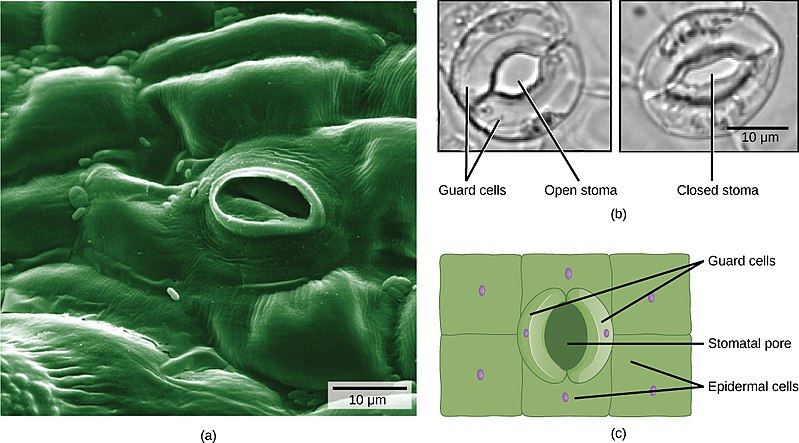Difference Between Stomata of Monocot and Dicot Plants
The key difference between stomata of monocot and dicot plants is that two dumb-bell shaped guard cells surrounds the stomata of monocot plants while two bean-shaped guard cells surrounds the stomata of dicot plants.
The stoma is an important plant structure that mainly involves the exchange of gases. It is a small pore present in the epidermis of leaves and stems. Guard cells are two cells that always surround the stomata.
CONTENTS
1. Overview and Key Difference
2. What is Stomata of Monocot Plants
3. What is Stomata of Dicot Plants
4. Similarities Between Stomata of Monocot and Dicot Plants
5. Side by Side Comparison – Stomata of Monocot vs Dicot Plants in Tabular Form
6. Summary
What are Stomata of Monocot Plants?
The stomata of monocot plants are tiny pores surrounded by dumbbell shaped guard cells. They are present in both upper and lower epidermis of the leaves. The stomata distribution of monocots has a special name, i.e., amphistomatic distribution since the stomata of monocot plants are equally distributed in both epidermises: upper and lower epidermis.

Figure 01: Stomata of Monocot Plants
However, there is a disadvantage of amphistomatic distribution of the stomata in monocot plants. To be specific, the rate of transpiration in a monocot leaf is higher than that of a typical dicot leaf. But monocot leaves possess different adaptations to prevent excessive water loss through transpiration. These adaptations include rolling of leaves and presence of sunken stomata.
What are Stomata of Dicot Plants?
The stomata of dicot plants are small pores surrounded by two bean-shaped guard cells. They are present in the lower epidermis of the dicot leaf. Therefore, the stomata distribution of dicot plants has a special term: hypostomatic distribution.

Figure 02: Stomata of Dicot plants
This unique distribution of stomata allows dicot plants to prevent water loss through transpiration and conserve water within the plant. A low minority of dicot plants also contain stomata in the upper epidermis. But these plants have special adaptations to prevent excessive water loss through transpiration.
What are the Similarities Between Stomata of Monocot and Dicot Plants?
- Stomata of monocot and dicot plants are small pores present in the epidermis of the leaves.
- Two guard cells surround both stomata of monocots and dicot plants.
- The role of both stomata involves transpiration and exchange of gases.
- Some species of both monocots and dicots contain sunken stomata to prevent transpiration.
What is the Difference Between Stomata of Monocot and Dicot Plants?
Stomata of Monocot vs Dicot Plants | |
| The stomata of monocot plants are tiny pores surrounded by dumbbell shaped guard cells and are present in both upper and lower epidermis of the leaves. | The stomata of dicot plants are small pores surrounded by two bean-shaped cells and are present in the lower epidermis of the dicot leaf. |
| Distribution | |
| Stomata of monocot plants exhibit amphistomatic distribution since stomata are present in both upper and lower epidermis of monocot plants. | Stomata of dicot plants exhibit hypostomatic distribution since stomata are present only in the lower epidermis in most of the dicot plants. |
| Shape of Guard Cells | |
| Guard cells of monocot stomata have the shape of dumbells. | Guard cells of dicot stomata have the shape of beans. |
| Adaptations to Reduce Transpiration | |
| Rolling of leaves and sunken stomata are adaptations of monocot plants. | Sunken stomata and absence of stomata in the upper epidermis are adaptations of dicot plants. |
| Advantages | |
| Effective gaseous exchange from both sides of the leaf occurs in monocots. | Less water loss by transpiration is an advantage of dicot plants. |
| Disadvantages | |
| High water loss by transpiration is a disadvantage of monocots. | Gaseous exchange takes place only from the lower epidermis is a disadvantage of dicots. |
Summary – Stomata of Monocot vs Dicot Plants
Stomata are important for gaseous exchange in leaves of both monocot and dicot plants. Two guard cells always surround the stomata. The guard cells of dicot stomata have shapes like beans while guard cells of monocot stomata have shapes like dumbells. The stomata of most dicot plants are present in the lower epidermis of the leaf whilst in monocot plants, they are present in both upper and lower epidermis. These are some of the differences between stomata of monocot and dicot plants.
Reference:
1.Cotthem, Willem Van. “Stomata of Monocots and Dicots.” PLANT STOMATA ENCYCLOPEDIA, 20 Jan. 2018, Available here.
2.“Stomata of Plants.” Study.com, Available here.
Image Courtesy:
1. “Zebrina stomata” By AioftheStorm – Own work (CC0) via Commons Wikimedia
2. “Figure 30 02 05abc” By CNX OpenStax – (CC BY 4.0) via Commons Wikimedia
ncG1vNJzZmivp6x7pbXFn5yrnZ6YsqOx07CcnqZemLyue8OinZ%2Bdopq7pLGMm5ytr5Wau26%2F06ikmqyRYrynecyopaibn6l6orrDZpuim5%2BperG4wKerrGc%3D